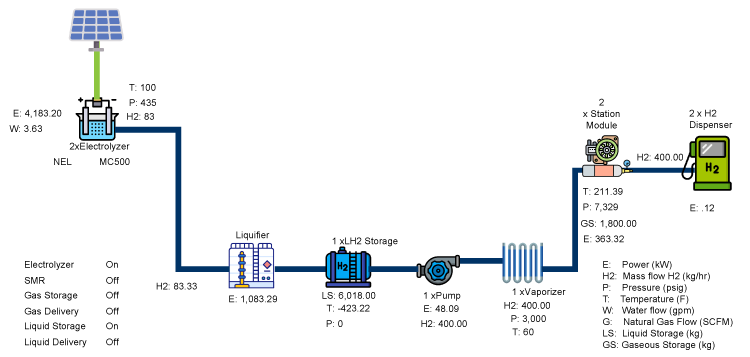A Planning Tool for Clean Hydrogen Energy
Across the globe, there has been a push for carbon reduction across all market sectors, and green hydrogen energy — hydrogen energy produced using clean or renewable energy — is emerging as a potential option. In the United States alone, the U.S. Department of Energy outlines strategic opportunities for producing 50 million metric tons per year by 2050 in the U.S. National Clean Hydrogen Strategy and Roadmap (pdf). Currently the United States produces just more than 10 million metric tons per year.
To help with emerging hydrogen energy projects, HDR developed a proprietary tool, sponsored through our unique Fellowship Program, that helps clients streamline the evaluation of hydrogen equipment and processes. We talked with the creators of this tool, Brandon Curry and Nick Barber, to learn more about how it works and what types of projects it can support.

How did this hydrogen energy planning tool come together?
Working in power generation, we see how hydrogen energy, specifically green hydrogen, has huge potential for growth in the coming years as a solution in the decarbonization movement. Our idea was to create a tool to make it easy for our clients to understand the options, cost, and the equipment and materials required to integrate hydrogen.
After being accepted into HDR’s Fellowship Program, we worked across our company's many areas of expertise, including power generation, building engineering, transportation, and oil and gas, to understand the various types of hydrogen equipment as well as project types. We performed extensive market research through public sources, like the U.S. Department of Energy, and equipment vendors to understand the current capabilities and availability of hydrogen-based equipment.
Based on that collaboration, we identified common threads and a list of major hydrogen equipment available in today’s market. The result is this unique piece of software that puts it all together.
What does the hydrogen energy planning tool do?
In a nutshell, the tool develops project-specific hydrogen processes and equipment configurations in a simple-to-understand flow diagram. It provides a lot of flexibility to customize for client or project needs. The tools model a potential system from energy input (solar, wind, etc.), to production (electrolysis, steam-methane reformation, etc.), through storage and delivery mechanisms, whether they be gaseous or liquid.
What the tool has really become is a starting point for hydrogen energy studies, allowing for the creation of multiple versions and configurations that compare different scenarios. For many of our clients, it can be hard to know exactly where to start. Implementing hydrogen-as-a-fuel in any fashion is a big step. This tool can do a lot of that early iterative legwork, so the client doesn’t have to start from scratch for every decision in the hydrogen value chain.
It also helps us track trends in the marketplace and stay up to date with new tools, so clients get the latest evaluations of costs, options and solutions.

What types of hydrogen energy projects can this be used for?
This can be used on any type of hydrogen-as-a-fuel project.
So far, our main uses cases have been studies looking at the transition of public transportation vehicles to hydrogen fuel cells. For example, we used it on a recent feasibility study (pdf) for the Kentucky Energy and Environment Cabinet to evaluate a transition to hydrogen-powered trucks. The graphics from our tool are showcased throughout the report, including the very first page.
Other uses cases have been:
- Studying the conversion from gas to hydrogen fuel cells for fleets in dense urban environments, where space is a major constraint. Our tool can compare generating hydrogen onsite, which takes up quite a bit of space, to trucking hydrogen in.
- For early planning studies, we’ve helped clients gain a high-level understanding of the equipment required to produce and store hydrogen. We’re partnering with the Washington State Department of Ecology to prepare for the development of green hydrogen energy in the state. Part of that work is providing information on existing and future transmission and transportation corridors, using information from hydrogen facilities in the U.S. and abroad.
- For the oil and gas industry, the tool can evaluate methods for providing hydrogen to blend into pipelines and estimate carbon savings achieved at various blending rates.
- In the traditional power generation space, natural gas is a prominent fuel. Recently there has been activity around converting natural gas-fired equipment to allow for operation on hydrogen. This tool catalogs publicly available information on hydrogen power generation capabilities, blending percentages and performance impacts for various pieces of equipment in one consolidated location.
- For building construction projects looking to decarbonize and lower footprints, they may look at clean hydrogen as a fuel source. Our tool is well-suited to evaluating the infrastructure needed for hydrogen-fueled microgrid applications, considering both the infrastructure required to produce, store and use green hydrogen on-site as well as fuel cells and other local generation options that can be fueled directly with hydrogen.
And those are just a few of the applications we’ve considered so far. As hydrogen energy projects become more prominent, more projects may emerge where this tool can benefit.


